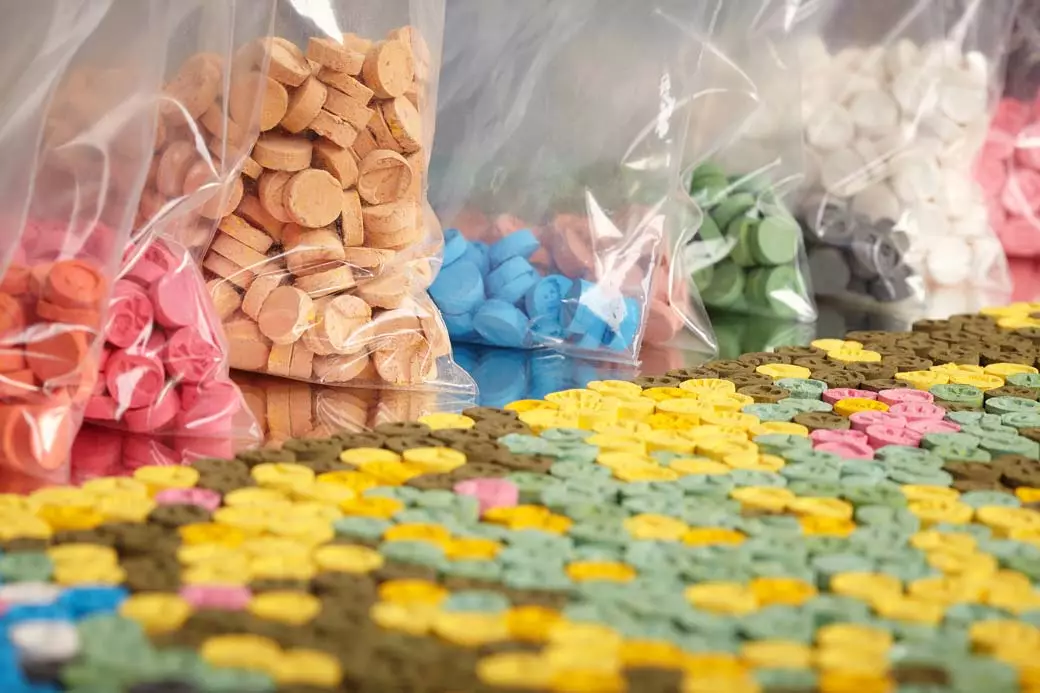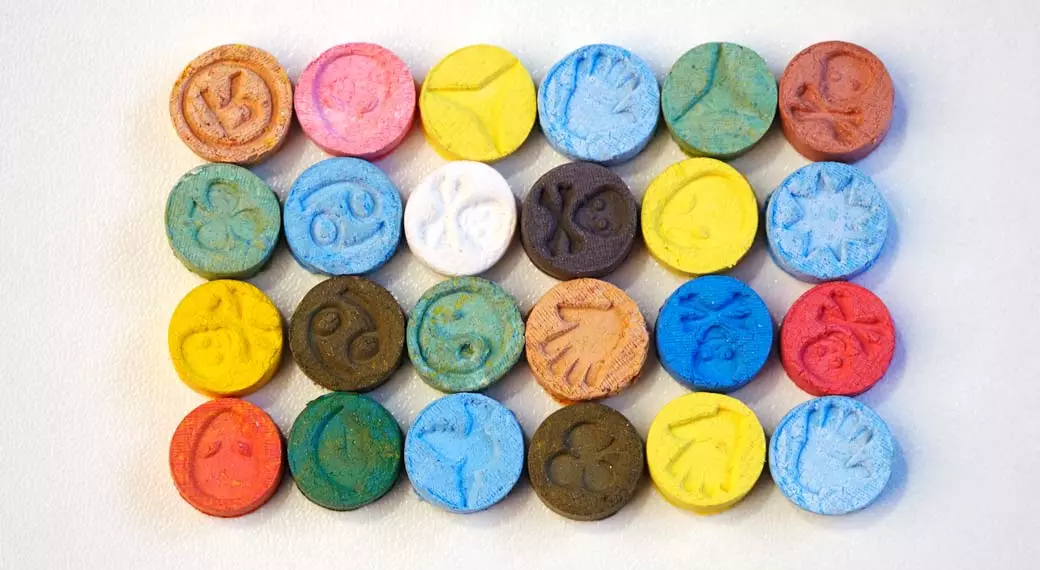Certain illegal narcotics exist that many people consider “harmless” and are looked at as more of a source of recreation instead of addiction. However, chemical, and even natural substances, should never be underestimated, as there is always a potential for addiction and physical harm.
This line of thinking is commonly applied to MDMA, otherwise known as Ecstasy – a popular drug among club-goers and attendees of jam band concerts. What many recreational users don’t know is that MDMA does have the potential for addiction, and other health risks can potentially be even more insidious.
Because MDMA comes in several different forms, it’s difficult to be sure with a 100% degree of certainty that the product they’re ingesting is indeed MDMA. The constant circulation of various analogs and research chemicals makes ingesting MDMA a gamble with your life each time.
In this article, we’ll explore one of the biggest questions surrounding this narcotic – is MDMA addictive? Continue reading for the answer to this and other questions regarding this “recreational drug.”
Is Molly or MDMA Addictive?
The answer to whether MDMA is addictive is relative. Many people that refer to addiction classify addictive substances as having properties of physical dependence. However, it doesn’t take physical dependence for an individual to develop a substance abuse disorder.
Substance abuse disorder is usually defined as a user that’s developed a certain level of tolerance to a drug with the clear presence of physical or mental withdrawal. Additionally, substance abuse disorder, besides the inclusion of the previously mentioned elements, also includes individuals taking a substance for non-medicinal purposes.
The Nature of Addiction in Individuals
When individuals don’t consume their substance of choice, they may find difficulty functioning in public situations or experiencing regular feelings of joy or pleasure. Without question, MDMA certainly fits all of these criteria.
While it’s questionable whether MDMA causes physical dependence, the mental aspect has a significant presence in long-term users. Depression and hopelessness are only a couple of multiple withdrawal symptoms during the MDMA detox period.
Before fully understanding the process of MDMA addiction and withdrawal, it helps to have a solid foundation of what MDMA is and its history.
What Is MDMA?
MDMA is a fully synthetic drug that doubles as a stimulant and hallucinogen. It produces a wide range of effects, including increased energy, a distorted view of time and perception, and a significant increase in feelings of enjoyment and pleasure.
The drug was first synthesized by the German pharmaceutical company Merck in 1912 and was initially referred to as Methylsafrylaminc. It was originally created as a parent compound to medications created to control bleeding levels.
In the beginning, MDMA never received any official human testing other than being given to German soldiers. The effects were never widely publicized or documented, and the drug initially failed to gain traction.
In the 1970s and 80s, the drug did increase in popularity among a small percentage of psychiatrists for treating PTSD. This was brought on by the accidental discovery of MDMA by Alexander Shulgin in 1978.
After his discovery, the drug eventually made its way into the club scene, where it was distributed in multiple forms, most notable Ecstasy, the pill form of MDMA. Since then, multiple forms of MDMA have been made formulated, many of which contain dangerous adulterants that have led to fatal encounters.
Differences in Types of MDMA and Molly
Molly is the street term used for MDMA in its purest powdered form. Otherwise, the drug is produced in a pressed-pill form, marketed under the name Ecstasy.
Another common slang term for MDMA is Adam, used as a counterpart for the club drug Eve. Eve is the compound MDEA, which is often contained in Ecstasy tablets or marketed as MDMA.
MDEA was heavily researched by Alexander Shulgin in the 1960s, reporting that it had a heavy down feeling, almost opposite to the energy caused by MDMA. The two can be dangerous if mixed together.
Methylene-dioxyamphetamine (MDA), otherwise known as “sass,” is another chemical commonly marketed as MDMA. This chemical is made from the sassafras root oil and has similar properties to Molly and Ecstasy.
The effects of MDMA or Molly can have a wide-ranging variety of feelings, depending on additional ingredients that might be contained in Ecstasy tablets or the powder when it’s sold as Molly. Potential adulterants contained in Ecstasy and Molly include the following:
- Fentanyl
- MDEA
- Methamphetamine
- MDA
- Heroin
- Cocaine
- LSD
- Mescaline
- Ketamine
- Dextromethorphan (DXM)
Is Molly Pure?
Many rumors circulate regarding the purity of Molly. It’s not uncommon to hear the rumor that the powdered version of the drug is pure, crystalline, lacking the high number of adulterants commonly found in Ecstasy pills.
While it’s true that Ecstasy pills contain high amounts of adulterants, the rumor about its counterpart Molly and its purity isn’t. In fact, reports compiled after testing over 20,000 batches of Molly secured from different sources showed that only about 55% contained pure MDMA.
This means that nearly half of all Molly circulating contains additional substances besides MDMA or no MDMA at all.
When ingested separate from adulterants, MDMA has the following effects:
The Effects of MDMA and Molly
MDMA has a large variety of effects when ingested and often comes in waves. These effects vary in intensity, depending on the amount consumed. The following is a list of the most common effects:
- Intensified feelings of pleasure
- Euphoria
- Increase in the sensitivity of touch
- Inflated sense of happiness or relaxation
- Altered time perception
- Changes in depth and light perception
- Possible mild hallucinations
- Increased empathy
These feelings are short-lived and often lead to an intense crash period. Many of the negative side effects include:
- High blood pressure
- Fainting
- Panic attacks
- Loss of consciousness
- Increased body temperature
- Jaw clenching
- Restless legs
- Headache
- Sweating
- Joint stiffness
Engaging in use over multiple days (binging), there is a potential for even further complications. Users may experience irregular heartbeat, depression, impaired memory, aggression, and irritability. After long-term use, users may suffer from sleep disturbances, loss of appetite, difficulty concentrating, heart disease, and decreased cognitive function.
To avoid the long-term effects of MDMA, individuals suffering from abuse challenges must seek treatment.
Treatment Options for MDMA Dependence

Multiple treatment options exist for MDMA dependence. While group recovery sessions and various talk therapies can be effective, one of the most widely-used treatment options for MDMA dependence is cognitive-behavioral therapy (CBT).
Medications exist that may effectively ease the discomforts associated with detox and withdrawal. However, there are no FDA-approved medications used to treat MDMA dependence. Regardless of this fact, it’s still possible to reverse the damage caused by MDMA abuse.
Can You Reverse the Damage Done by MDMA?
Reports have shown cognitive challenges associated with long-term MDMA use and other negative health complications. While these conditions are serious, it is possible to experience a reversal of these symptoms.
Long-term treatment for MDMA addiction is the appropriate course of action for reversing these symptoms and remedying the underlying causes of MDMA abuse disorder. What are the potential options for this treatment?
Long-term Treatment for MDMA Addiction
Long-term treatment for MDMA addiction includes the option of inpatient and outpatient treatment.
Inpatient Treatment
Inpatient treatment includes a healthy mix of mental health and substance abuse counselors creating a personalized treatment plan for recovery. Regular meetings with both, combined with group recovery sessions, provide clients with education regarding underlying mental health conditions and behavioral challenges that lead to substance abuse.
Other activities may include holistic options, which can be especially helpful in treating MDMA abuse. Dietary plans are crafted to promote a healthy mind and body, further advancing the client’s chances for recovery.
Outpatient Treatment
Outpatient treatment is an option for clients who aren’t able to attend inpatient services for the allotted 30, 60, or 90 days. The same services are required to complete graduation. However, clients may attend commuting from home, participating for an estimated 9 to 20-plus hours per week.
Aftercare Services
Aftercare services and a strong support system are always important during recovery. These include continued participation in mental health counseling and group recovery meetings.
Because of the intense depression and feelings of emptiness experienced due to the loss of serotonin and other chemicals in the brain, it’s critical that clients find hobbies and activities they enjoy. Things like painting, time with animals, boating, crafts, and building activities may fill the void caused by MDMA.
Combining all of these dynamics make recovery from Molly and MDMA addiction possible.
Recovery from Molly and MDMA Addiction Is Possible
At Circle of Hope Treatment, our team believes in long-term recovery from all substances, including MDMA. We provide all the elements mentioned above via our experienced and compassionate team and their vast amount of experience.
Contact a member of our admissions staff to find out how we can assist you during your journey toward recovery.
Further Information: MDMA FAQs
Is MDMA Addictive?
While it’s questionable whether MDMA is physically addictive, this substance certainly has all of the properties needed to classify it as addictive.
- Users develop a clear tolerance to the drug.
- Long-term users develop a clear need for the drug to function or experience normal feelings such as joy, pleasure, and others.
- There is a withdrawal period experienced when users abstain from the drug.
These combined characteristics classify MDMA as addictive with 100% certainty. Although it can’t medically be considered physically addictive, there have been cases where dependence on the drug can cause physical addiction.
Is MDMA Lethal?
Although no clear toxicity level exists for MDMA, certain complications caused by overuse have caused fatalities. Cardiac arrest and stroke caused by overuse have led to fatalities in the past.
However, hyperthermia, or the overheating of the human body, has been the most significant culprit in this regard. When this takes place, potential brain damage and shutdowns of the body’s vital organs can be the result.
Additionally, the body retaining water can further complicate this situation, leading to kidney failure as a result. While it’s important for users to remain hydrated during Ecstasy intoxication, over ingestion of water can prove to be fatal.
Is Molly the Pure Form of MDMA?
Plenty of rumors circulate regarding the purity of MDMA in the form of Molly. Molly is the powdered version of MDMA, often appearing as an off-white, crystalline substance, although it can also come in a purple or yellow color.
Although Molly is the precursor for Ecstasy, the pressed tablet version of MDMA, this doesn’t mean the version released for street consumption is pure. Nearly 50% of all batches of Molly were found to contain adulterants other than MDMA.
Most recently, there’s been a huge issue with batches of Molly and Ecstasy pills containing fentanyl, leading to fatal overdoses at concerts and other venues. The website Dance Safe contains information regarding certain brands of pressed pills, although it’s difficult to be certain of the purity of Molly.


